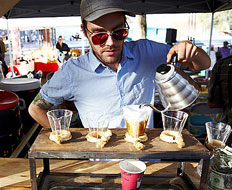The food truck trend has gathered so much steam that there wouldn’t seem to be enough tires left in America to get another mobile kitchen trend like the food bike rolling along.
While the number of food bikes pedaling through city streets doesn’t compare to the number of food trucks, they’re quickly becoming a go-to mobile option for urban operations.
As bike-powered foodservice concepts become more common in dense, urban areas around the country, the possibility of food trucks yielding to their two-wheeled (or sometimes three-wheeled) cousins seems more likely.
Feverish is one such example of a bicycle-based food concept. A gourmet popsicle and ice cream business based in Miami, Feverish started in 2008 with Felecia Hatcher and her husband, both former Nintendo marketing managers, roaming the city streets on “ice cream tricycles” they bought off of Craigslist.com.
Feverish identified itself as eco-friendly on the basis of its vegan product and mode of transportation, but eventually switched from the tricycles to a small green SUV because transporting the tricycles around Miami, a notoriously sprawling city, was difficult.
Nonetheless, Feverish is now switching back to the tricycles for a range of reasons. One is that they allow Hatcher’s crew to come and go as they please, which is not true of trucks, she says.
“We’re able to do farmers’ markets and other really cool events, whereas our truck and other food trucks can’t do them because they can’t get into those areas,” Hatcher says. “And we can leave an event if it sucks, which is something we couldn’t do with our truck. With so many people around, you can’t just drive away whenever you want to. You have to stay put all day.”
The tricycles also bolster Feverish’s identity as a brand with an environmentalist bent, Hatcher says.
“We want to be as eco-friendly as possible,” she says. “This is the way society is going. People are trying to lessen their carbon footprint. [Increasingly,] more people are on bikes as opposed to cars.”
Even though Hatcher says she hasn’t heard that any of her colleagues in Miami’s burgeoning mobile kitchen scene are also planning to trade in their trucks for bikes, she expects “way more are going to pop up.”
Up the eastern seaboard, Kickstand Brooklyn is a coffee concept that, as its name implies, peddles its java via a bicycle. “The bike-pulled coffee bar” serves up hot and cold coffee made from beans that are ground and brewed on the spot.
“We could serve coffee fresh in a field if we wanted to,” co-owner Neal Olson says.
The Kickstand crew tows its coffee bar around the city in two 180-pound sections, often setting up shop at farmers’ markets and movie sets where they can piggy-back on existing permits. Securing a street vendor permit for the company, Olson says, would be prohibitively expensive.
“New York City does not make it easy for street vendors to operate,” he says. “It would be ideal if we could set up [anywhere]. If we could set up outside of outlying train stations when we know it’s going to be rush hour, I think we would do really well. But because of licensing issues, we can’t just roam around and claim a spot.”
Despite the permitting issues—which also frustrate many of the city’s food truck operators—Kickstand Brooklyn does 60 percent of its business on the streets and the rest through a weekly bike delivery service.
“The ties between coffee drinking and cyclists have always been super strong,” Olson says. “There are a number of coffee shops that are also bike shops because it is a ritual of cyclists to get an espresso before or after their weekend ride.”
This partly explains why so many of the existing bike-powered mobile kitchens are coffee concepts, including Equal Exchange’s Free Range Café in Boston, the Good Bike in Austin, Texas, and Café Velo in Portland, Oregon.
One drawback to the food bike is that it can only serve a limited range of items because of its limited size and man power.
This limitation is why James Sinclair, a restaurant consultant at OnSite Consulting in Los Angeles, is skeptical about the bike’s ability to anchor a foodservice business.
“I don’t think you should be doing it as a stand-alone [operation],” Sinclair says. “You’re not going to pay your rent off a bike because, as a business model, it’s slightly limited.”
Rather, Sinclair says, restaurant chains should consider deploying bikes as an extension of their brick-and-mortar locations.
“I think it would make a phenomenal marketing campaign,” he says.
As for whether the bike kitchen can catch on if it isn’t attached to a global brand like Starbucks, Sinclair says it is possible.
“Do I see them blowing up? I’m sure they could, but the revenue is limited to a certain degree,” he says.
Back in Brooklyn, Olson sees it differently. He and his friends were able to kick-start Kickstand “out of pocket,” he says, and the overhead in a bike-centric business is “pretty darn low.”
The teams behind Kickstand and Feverish are convinced that they are catering to an ever-growing market of consumers who care about the environment and prefer a specialized concept to the expansive menus of chain restaurants.
“You can ride your bicycle to work, but you can also start a business with it,” Olson says. “That’s pretty exciting to us.”













